Library Management System
Description:
A library management system is an application that applies to small or medium-sized library systems. It is used by librarians to operate the library using a computerized framework that allows them to track different information. Transactions such as book problem, return, inclusion of new books, addition of new pupils, and so on. This framework also includes books and student maintenance modules, which maintain track of how many students are using the library and provide a comprehensive overview of the books available.
There will be no lack of book or participant records for this computerized system, as is common in non-computerized systems. In addition, the Library Management System has a summary module.
If the user is an administrator, he or she can create reports such as lists of students enrolled, lists of books, and issue and return reports. In comparison to non-computerized library systems, both of these modules will assist librarians in managing the library with greater ease and efficiency.
AIMS AND OBJECTIVES:
This subchapter discusses the project's goals and priorities that will be accomplished after it is completed. The below are the goals and objectives:
- Publication of an online book
- A column for librarians to make requests for new books.
- A column dedicated to public libraries
- Login page for students, where they can view books given to them and their due dates.
- A column for searching the supply of books
Requirements:
- When planning the Library Management System, we would also pay attention to the following set of requirements:
- Any library patron should be able to browse for books by title or other categories.
- Each book will be assigned a unique identifying number that will aid in its tracking.
- Each edition of a book is referred to as a book object because there are several copies. The device should be able to retrieve user information via library member.
- There should be a (5) overall number of books that a member will check out..
Planning:
- Creating acceptable project reports, including a danger log.
- The project's primary milestones will be identified.
- Detailed identification of services available.
- Determination of the project's effect on other capital
Problems face in library system:
- Specialized personnel:
Any institution that has created a digital library must have a skilled and competent workforce.
- Long-term funding:
The digital library requires material financial assistance in order to manage digital information and provide customers with immediate access.
- Intellectual property rights protection:
Adherence to copyright and intellectual property rights concerns is a huge institutional obstacle.
Stakeholders:
University: Ensure that the library has enough educational resources.
Librarian: In charge of the library system as well as other facilities.
Finance and resource management are the responsibilities of the library superintendent.
Device manager: Ensure that the system is functioning properly.
Librarian tutor: Have consultation and aces book for purchase..
Maintaining the catalogue inquiry service is the responsibility of the catalogue librarian.
Issue and renew library products, as well as work with inquires, as a library assistant.
Library user: Take advantage of the library's services, such as borrowing books..
Success Criteria:
Our primary objective is to complete this project on time and under budget. While the library management system is being designed and checked, as well as after it is rolled out, a mechanism for collecting the value must be developed. If the project takes longer to finish or costs more than anticipated, If it gets a decent payback and helps promote the firm's reputation as an outstanding management company, the firm will always consider it a positive.
Recognize the Library's Authority:
This involves understanding the various personas that will occupy roles in the library administration, as well as the possible hierarchy, defining criteria and assignments, and delegating duties in various fields. Finance, content, and other services are among the fields in which a successful library must function.
Understand What It Takes to Run a Library:
It takes a lot more than taking books out and restocking shelves for library patrons to run a library. Library administration entails a variety of tasks, including planning. Make recommendations on the library's priorities, scheduling, and assembling, among other things. Libraries must also keep track of their different success indicators and even take the lead in encouraging high performance.
Make use of the library's tools and resources:
In the case of a big library facility, it's critical to learn about the accepted tool and system specifications, as well as what the library can provide according to local government. A stacking office, a librarian's room, and structural arrangements are all needed by certain governments. Also with the necessary sitting capacity to match the number of reading materials, according to the number of books to be made available.
Scope:
The library management system that will be implemented provides university library students and staff with books, information on book viewing, and a variety of other services. The following functions are expected to be included in the library management scheme.
The key goal of this method is to help people track how much time they spend on each task, as well as to help them use resources more efficiently by increasing their productivity by automation. The system also generates various types of data that can be used for a variety of purposes.
Initial public release:
A stable internal network and a library administrator portal will be included in the early release of the new system, as well as an online entry form for students, an online E-book portal, and a backend database to handle and archive registration details and Library System information. This initial update would also provide installation setup and service manuals for librarians, students, and personnel at the university. Since the initial release would be completely functional, it is critical to provide user and technical support documents so that the E gateway can be conveniently used and configured in the current library environment.
The product gives users the ability to block books electronically, and the library management system is available 24 hours a day.
future Release scope:
- access to student information through the internet
- Allow the department to evaluate the knowledge and feedback from the students.
- Analyzing customer reviews and other inquiries, etc.
- Student records can be edited online.
- Resolve any problems with the online books.
There is a lot of knowledge potential in implementing a Library Management System, and it also alleviates a lot of the admission pressure.
Assumptions, Constraints and Milestone
Both of the information entered will be accurate and up to date. The sun micro architecture was used to create this software kit, which has a java front end.
The following third-party items are required by the manufacturer.
- The database will be stored on a Microsoft SQL server.
- ASP.net was used to create the product. Page 4 of the WLMS Software Requirements Specification This system's effectiveness is contingent on
- Existence of an Internet connection for all Gaza Strip residents.
- Are librarians and consumers familiar with computers and have sufficient knowledge to use the product?
- The user interface of the website must be helpful and simple to use.
- The search process should be straightforward and fast.
Constrain:
- The information collected is vulnerable to cyber-attacks. Choosing a trustworthy online system reduces the danger.
- Expensive and difficult to run
- Online networks need high-speed internet access
- Computer virus risk
- The automated capability is not accessible in offline/open source systems, so operations must be performed manually.
- Unlike cloud-based online services, Open-source systems save files on a computer's hard disc. This raises the possibility of data loss.
Since this device is web-based, PC Server hardware that is connected to the internet would be required. The DLS System has the ability to have hundreds of users. It is impractical to expect everybody to receive instruction. As a result, the interface should be simple to use, with clear support instructions and acceptable error messages for incorrect user feedback. The operation of a library requires a high level of security.
The DLSSYSTEM is only available to library users for searching book information. The user should never be able to hack into the system and make changes. The functioning of a library requires a high level of dependability. During library operating hours, the DLSSYSTEM does not experience any unplanned downtime. Any downtime during operating hours has a huge effect on the library's operations and causes discomfort to all patrons.
User Interface Functional Specifications:
User interface requirements deal with the user interface and how information is communicated to the user.
- Users can communicate with the device via Usability Interfaces, which are a key class of components within the DML. As a result, when the user isn't idle, both interfaces can have quick access to support and clearly show the current status of the user's transaction. Each interface component MUST display the transaction and error status. Text cut and paste inside interfaces, as well as in and out of interfaces, MUST be provided.
Administrative:
Library staff can benefit from administrative interfaces that help them build/maintain collections and manage access to them. Because of the data model's sophistication, Library Staff would need to be able to edit several documents at once and connect them together. Administrative staff MUST be able to edit several documents at the same time. Without having to type in database identifiers, the administrator MUST be able to establish connections (references) between documents.
User account management system in the library:
The system can view user account information such as user ID, last and first name, user position, and privilege. The framework will employ a graphical user interface that will enable librarians to perform tasks such as deleting, modifying, and inserting user accounts and account records.
Logging:
Logging can be used within the system to include a trail of transactions that have occurred. This may be for debugging purposes for developers, administrative use tests, or analysis into the usability of interfaces. For each service rendered, transaction records MUST be maintained. To support user activity review, sufficiently comprehensive client session logs MUST be produced.
Work breakdown structure WBS:
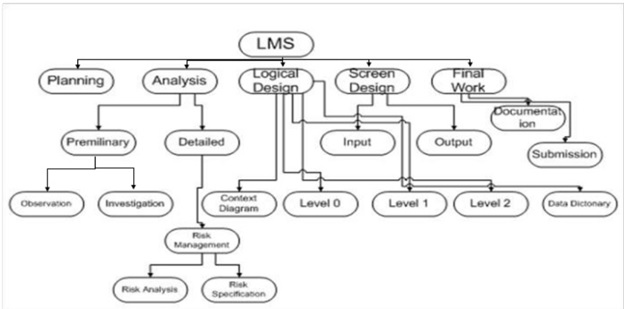
Module for authorization:
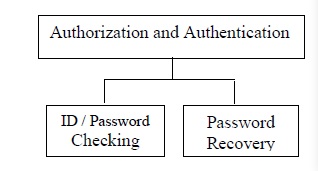
The customer, who in this case means librarians in the library, uses this module. They must connect to the server with their id and password in order to distinguish the user level. After successfully logging in, they will have access to various modules..
Module for Maintaining a Book:

Any user at any stage can access the Book module. This module is used to keep track of the book inventory, including searches, additions, and edits. In addition, we can create and print the barcode for the specific book so that the librarian can stick it on the book cover.
Module for Publish Upkeep:

This plugin allows you to add and update the publisher of a novel. When registering a new publication, the term "publisher" is used.
Module for booking transactions:
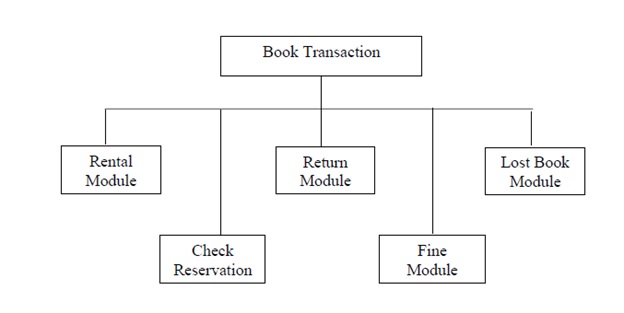
A key module in a library management scheme is the book transfer module. When a member needs to borrow a book, return it, or register a lost book, it goes into the book transition module. This module can be used by either a regular user or an administrator.
When a member wants to borrow a book, the librarian must first check their member id before scanning their book barcode id. If the book is reserved, it is not possible to rent.
The librarian simply scans the book barcode id and checks the rental details with the recipient for the return module. If the rental information is right and no fines have been imposed, the return module will be completed.
Module for student:
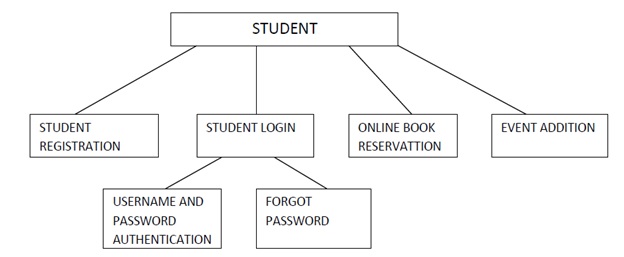
Student registration, student login, online book reservation, and event extension are all included in the following module. If a student forgets his password, he can recover it using the forgot password option.
Module for Reports:

The admin user's key module is the report module. The reason for this is that regular users are not permitted to access the article. There are three kinds of repots. The first is a transaction log, which will show how he booked transactions on a certain date, such as a leasing report and a return report.
The top ten rental rate book is the Top10 report. The information can be filtered by book group and date in the regular, weekly, and yearly formats.
Module for member and personnel management:
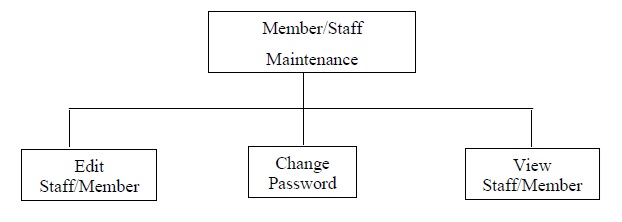
This module allows users and administrators to browse each other's profiles. They also allow users to update their profile and change their password.
Module for search:
Users or guesses who use the website will use the search module to look up information in the novel. Not only can the customer see the book's descriptions, but they can also see the book's remarks. There are a few forms that allow users to browse. They will look for books by title, author, or publisher.
Project schedule:
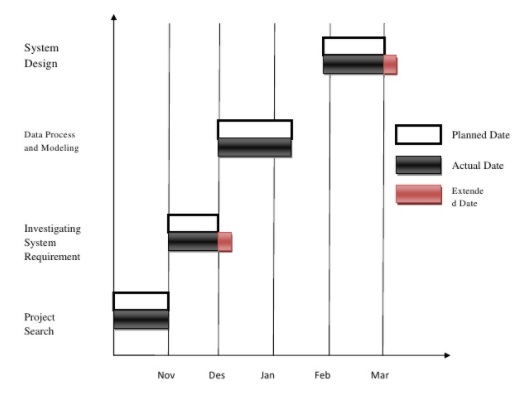
Social, ethical, legal :
Social, ethical:
The problem of the library's own structure, the problem of the library personnel, and the problem of readers are all considerations that contribute to information ethics. The library is in the midst of being managed, but it hasn't absorbed sophisticated organizational ideas, and information ethics isn't part of the management spectrum, so the structure isn't in place. Since there are no system standards, library personnel must follow the beaten path. As a result, they are indifferent to information ethics considerations in the operation process, disregarding customer privacy and other similar issues, and the school library management system has become a kind of paternalistic management, unable to listen to students' views, resulting in information. Furthermore, the key consumers of material in the library of a higher vocational college are pupils, who use it according to their own tastes. Certain students, with a feisty personality, deliberately breach the library's management structure.
The development of applicable information ethics and principles is an integral aspect of the library management system's information ethics building. Provide detailed directions to library personnel, visitors, and information activities in order to increase the consistency of library information services. To avoid and monitor the lack of normal behavior, protection technology is used.
The aim of filtering software and rating systems is to set up various levels of information access, the library information tools into the library of information filtering and classification, the illicit and dangerous information filtering, and to ensure that a single user does not engage in unethical conduct.
Legal implication:
Libraries use library management systems (LMS), also known as advanced library systems, to catalogue their collections and maintain their users' accounts. Personal information is obtained from users for a number of purposes, and the LMS keeps track of what things they borrow, holds they put, and any fines or penalties they may incur. Furthermore, the LMS may exchange data with or provide services to other library systems.
When applying for a library card or borrowing materials for the first time, users should be informed about the library's privacy policy. Users should have easy access to and understanding of library privacy policy in a way that they can read.
Consent of the User:
The library should allow LMS customers the option of controlling how much publicly identifiable information is stored and used. Users should have the option of opting in or out of features and facilities that include personal information processing.
Personal Data Access:
Users should be able to view and analyses their own personal information. Verifying accuracy ensures the proper operation of library facilities that depend on personally identifying information. The customer should be given simple and easy-to-find instructions about how to access their personal data stored in the LMS.
Passwords and PINs:
Personal identity numbers (PINs) and passwords contained in the LMS should be encrypted so that only the user can see them; library personnel should not be able to see them.
Conclusion:
We are confident that after the redesign is finished, the original system's challenges can be resolved. To - human mistakes and improve performance, the “LIBRARY MANAGEMENT SYSTEM” method was computerized. This project's key goal is to reduce human effort. Since all of the documents are kept in the ACCESS folder, data can be accessed quickly, information management is simplified. To man oeuvre through the vast number of records, navigation controls are available in both ways. If there are a lot of documents, the user will just type in the search string and get the answers right away. The editing process has also been simplified. To update the requested field, the user simply needs to type in the appropriate field and press the update button. A special id number is assigned to both the books and the students. In order for them to be accessed properly and without mistakes. The project's key goal is to provide accurate information about a certain student as well as books available in the library.
The concerns that occurred in the previous method have been largely eliminated. And it is anticipated that this initiative will go a long way toward meeting the needs of the consumers. The computerization of library management will not only increase productivity, but it will also reduce human fatigue, thus increasing human resources indirectly.
Many other elements, such as online lectures and video guides that teachers can include, as well as online homework submission, or a community chat where students can address different engineering topics, can be introduced to this project in the future, making it more social and user friendly.
References:
[1]. Lim, EP. Chen, H. Neuhold, E. et al. “International Journal on Digital Library”, Springer-Verlag (Nov 2004).
[2]. Earnshaw, R.A. Vince, J.A. “Digital Convergence – Libraries of the Future”, pp. 447. Springer, London (2008).
[3]. R. Earnshaw, “State of the Art in Digital Media and Application”, Springer Briefs in Computer Science, (2017).
[4]. Margaret L. Hedstrom, “Digital Preservation: A Time Bomb for Digital Libraries”, Published in Computers and the Humanities, (1997).
Library Management Assignment Code
<!DOCTYPE html>
<html lang="en">
<head>
<meta charset="UTF-8">
<meta http-equiv="X-UA-Compatible" content="IE=edge">
<meta name="viewport" content="width=device-width, initial-scale=1.0">
<title>Library Management</title>
</head>
<body>
<style>
*{
margin: 0;
padding: 0;
}
.container{
max-width: 1200px;
margin: 0 auto;
padding: 0 15px;
}
.wrapper{
display: flex;
flex-direction: column;
min-height: 100vh;
overflow: hidden;
}
.loader {
border: 6px solid #f3f3f3;
border-radius: 50%;
margin: 20px auto 0;
border-top: 6px solid #000;
width: 50px;
height: 50px;
animation: spin 2s linear infinite;
}
.loader__hidden{
display: none;
}
@keyframes spin {
0% { transform: rotate(0deg); }
100% { transform: rotate(360deg); }
}
.header{
width: 100%;
height: 100%;
position: relative;
}
.header__img{
min-width: 100%;
min-height: 100%;
top: 0;
left: 0;
position: absolute;
}
.header__img img{
width: 100%;
height: 100%;
object-fit: fill;
}
.header__content{
background-image: url('https://assets.ccbp.in/frontend/dynamic-webapps/book-search-bg.png');
background-repeat: no-repeat;
background-size: 100% 100%;
background-size: cover;
min-height: 300px;
width: 100%;
display: flex;
flex-direction: column;
justify-content: center;
align-items: center;
text-align: center;
}
.header__title{
color: #fff;
}
.header__input{
margin-top: 10px;
padding: 7px;
font-size: 14px;
border-radius: 4px;
}
.main__content{
display: flex;
flex-wrap: wrap;
gap: 20px;
padding-bottom: 20px;
}
.main__title{
margin: 20px 0;
}
.main__title_no-found{
margin-top: 20px;
text-align: center;
}
.book{
display: flex;
flex-direction: column;
flex: 0 1 15%;
text-align: center;
}
.book__img{
width: 100%;
height: 100%;
flex: 1 1 auto;
}
.book__img img{
width: 100%;
height: 100%;
object-fit: cover;
}
@media (max-width: 600px) {
.book{
flex: 0 1 30%;
}
}
@media (max-width: 430px) {
.book{
flex: 0 1 45%;
}
}
.book__author{
margin-top: 10px;
}
</style>
<div class="wrapper">
<header class="header">
<div class="header__content">
<h1 class="header__title">Library Management</h1>
<input type="text" placeholder="Type book title" class="header__input" id="searchInput">
</div>
</header>
<main class="main">
<div class="loader loader__hidden" id="loader"></div>
<div class="container" id="searchResults">
</div>
</main>
</div>
<script>
const inputEl = document.getElementById('searchInput');
const searchResults = document.getElementById('searchResults');
const loader = document.getElementById('loader');
function insertBooks(books) {
let resultEl = ''
if (books.length) {
let booksEl = '';
for (const book of books) {
booksEl += `
<div class="book">
<div class="book__img">
<img
src="https://www.assignmenthippo.com/webimg/ahp/sample-assignment/${book.imageLink}"
alt="${book.title}">
</div>
<p class="book__author">${book.author}</p>
</div>`
}
resultEl = `
<h1 class='main__title'>Popular books</h1>
<div class='main__content'>${booksEl}</div>`
} else {
resultEl = '<h1 class="main__title_no-found">No results found</h1>'
}
searchResults.innerHTML = resultEl
}
async function getBooks(event) {
if (event.key === 'Enter') {
try {
searchResults.innerHTML = ''
loader.classList.remove('loader__hidden')
const link = event.target.value
const response = await fetch(`https://apis.ccbp.in/book-store?title=${link}`)
const data = await response.json()
const books = data.search_results
insertBooks(books)
loader.classList.add('loader__hidden')
} catch (e) {
console.log(e);
loader.classList.add('loader__hidden')
}
}
}
inputEl.addEventListener('keypress', getBooks)
</script>
</body>
</html>
Want to order fresh copy of the Sample Library Management System Assignment Answers? online or do you need the old solutions for Sample Library Management System Assignment, contact our customer support or talk to us to get the answers of it.

